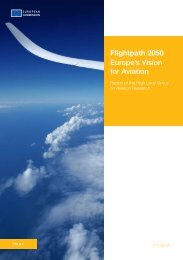Create
Final Report - Acare
Final Report - Acare
- No tags were found...
You also want an ePaper? Increase the reach of your titles
YUMPU automatically turns print PDFs into web optimized ePapers that Google loves.
THE IDEAS<br />
IV.<br />
The luggage system would be multi-modal<br />
using trucks, rail, and both passenger service<br />
aircraft and dedicated freight airlines. Space<br />
would be rented from the airlines for freight<br />
capacity using the existing facilities. High<br />
technology tagging would help to ensure<br />
that baggage items did not get lost. Early<br />
booked-in baggage could benefit from<br />
early flights, either on the same airline or<br />
different ones unseen by the passenger.<br />
The system would not have the arbitrary<br />
stocking and de-stocking of connecting with<br />
the passengers’ flight but would operate on<br />
a minimum holding time basis. Bags would<br />
go to the nearest airport to destination on<br />
the next flight after the bag was received<br />
at the departing airport (which might be a<br />
passenger airport or a dedicated<br />
freight airport).<br />
that are dedicated for specific destinations.<br />
Currently some airports have terminals that<br />
are specifically designed for specific carriers.<br />
The concept proposed would not take the<br />
carriers as a starting point but rather the<br />
destinations. As a consequence, for example,<br />
the “New York” terminal would service all<br />
flights to New York independent of the<br />
airline. If one carrier is delayed the passenger<br />
could immediately see if another flight is<br />
available. The idea behind the designated<br />
terminals could also be that ground traffic<br />
could be distributed amongst a number of<br />
terminals. The disadvantage would be that<br />
as most intercontinental flights depart at<br />
about the same time in view of the world<br />
Fig.12. Artist’s<br />
impression of a multi<br />
modal airport. Passenger<br />
containers can be loaded<br />
on trains, lorries or<br />
through the air. These<br />
containers form an<br />
integral part of a future<br />
airliner<br />
Separating passengers and luggage may result<br />
in additional flights or ground movements<br />
which would not be a preferred solution<br />
in view of the environmental impact.<br />
Furthermore, aircraft would need to be<br />
adapted as modern airliners have large cargo<br />
bays which would not be needed if luggage<br />
were flown in dedicated freighter aircraft.<br />
However, with flexible scheduling the same<br />
number of airliners could carry the same<br />
amount of luggage but more effectively from<br />
a customer perspective.<br />
If O/D traffic or transfer passenger flows<br />
are thick, a concept could be to have<br />
interconnected HUB airports. One step<br />
further would be airports or HUB-terminals<br />
Fig.13. Artist’s impression of loading passengers and<br />
freight containers into a BWB aircraft<br />
61



